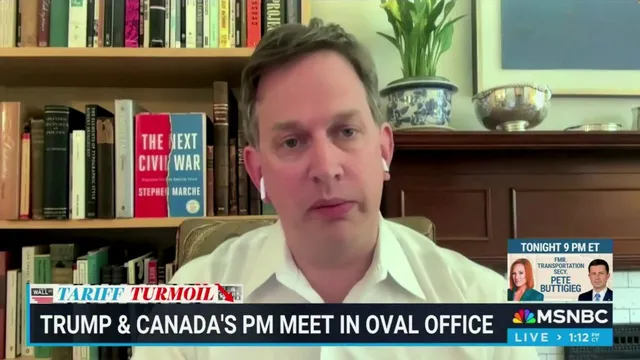
Canada stands firm against Trump's annexation proposals
2025-05-06 19:51- Mark Carney held his first meeting with Donald Trump as Canada's new Prime Minister on May 5, 2025.
- During the meeting, Carney firmly stated that Canada is not for sale amidst Trump's suggestion of incorporation.
- This meeting marked a significant test of Carney's commitment to standing up against Trump's influence.
Express your sentiment!
Insights
On May 5, 2025, Canada's new Prime Minister Mark Carney met with US President Donald Trump at the White House for their first in-person encounter since Carney assumed office. This meeting occurred shortly after Carney's electoral victory marked by a campaign promise to oppose Trump's provocative rhetoric and policies. During their discussions, which began on a positive note with Trump complimenting Carney, the Canadian Prime Minister reiterated his commitment to Canadian sovereignty. He firmly stated that Canada is not for sale, responding directly to Trump's suggestion of incorporating Canada into the United States as its 51st state. The encounter highlighted the underlying tensions in the Canada-US relationship, particularly due to Trump's imposition of tariffs on Canadian goods, including aluminum and steel. Trump highlighted what he termed a US subsidy of Canada’s military and expressed skepticism regarding the necessity of Canadian supplies, even while emphasizing ongoing friendship despite differences. The two leaders engaged in this dialogue amidst broader concerns about trade practices and economic collaboration, with Carney prepared to assert Canadian interests as Trump's administration has previously made veiled threats concerning Canada’s economic and political sovereignty. Carney's election was influenced by Canadian public sentiment regarding Trump's approach, which has often been characterized as confrontational, particularly on issues like trade and security. Trump's past relations with Carney's predecessor, Justin Trudeau, were marked by tension and public disputes, underscoring the importance of Carney's promise to adopt a different approach. By taking a firm stance against Trump’s overtures about annexation and asserting that Canada has well-defined boundaries, Carney aims to reassure Canadians of his commitment to their national interests while navigating complex bilateral relations. In this first meeting, Carney not only stood his ground but also implied his intention to craft a mutually beneficial relationship that respects Canadian sovereignty. The meeting served as an essential early indicator of how Carney intends to address the unique challenges posed by US policies under Trump, focusing on building economic cooperation while firmly asserting Canada’s autonomy. This initial diplomatic engagement sets the stage for future interactions, with both leaders keenly aware of the political and economic intricacies that lie ahead.
Contexts
The historical context of Canada-U.S. relations is characterized by a complex interplay of cooperation, conflict, and mutual influence that has evolved over centuries. This relationship has been shaped significantly by geographic proximity, economic interdependence, and shared cultural values. The early years of interaction were marked by colonial powers; both nations had their origins in British and French colonization, leading to early trade relationships. However, these interactions were fraught with conflict, particularly during events like the American Revolution, which resulted in a significant influx of Loyalists into Canada, shaping its political landscape and demographic makeup. Throughout the 19th century, as both countries expanded westward, the Oregon boundary dispute and the War of 1812 became critical moments that highlighted tensions, yet they also set the stage for future reconciliation and partnership. With the establishment of the British North America Act in 1867, Canada achieved confederation, and increasing economic ties further knitted the two nations together. The 20th century heralded a new era of collaboration, particularly during World War I and II, where both countries fought alongside each other. Post-war, the establishment of the North Atlantic Treaty Organization (NATO) and the United Nations saw Canada and the United States working together on defense and international diplomacy. The 1949 Ogdensburg Agreement also marked a significant commitment to defense cooperation, laying a foundation for future military collaboration, particularly during the Cold War. Economic integration took a more formal approach after the establishment of the Canada-U.S. Free Trade Agreement in 1989, which was later expanded into the North American Free Trade Agreement (NAFTA) in 1994. This legislative framework significantly enhanced trade and economic relations, making Canada one of the largest trading partners of the U.S. and vice versa. However, this economic interdependence has also led to periodic friction over trade issues, environmental concerns, and energy policies, often requiring diplomatic negotiation to maintain stability in the relationship. In the 21st century, Canada-U.S. relations face new challenges and opportunities, including addressing climate change, national security, border management, and immigration policy. The rise of global challenges such as terrorism and cybersecurity threats has necessitated stronger collaboration between the two nations in numerous sectors. While political changes in leadership can affect diplomatic tones and agendas, the underlying ties of trade, culture, and mutual interests suggest a resilient and enduring partnership. As both countries navigate this evolving landscape, the historical context of their relationship provides a crucial framework for understanding and addressing contemporary issues.